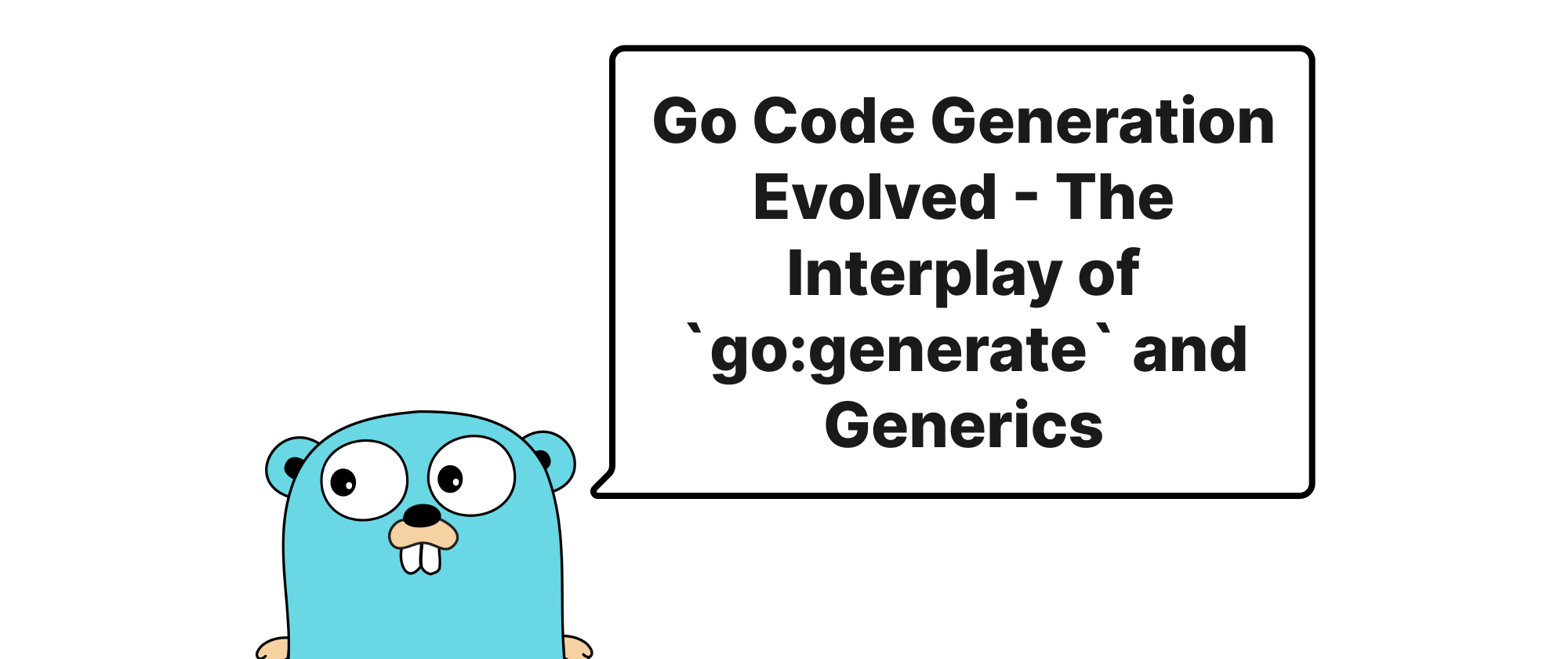Go Code Generation Evolved - The Interplay of `go:generate` and Generics
Daniel Hayes
Full-Stack Engineer · Leapcell

Introduction
For many years, Go developers have leveraged clever techniques to overcome the language's initial lack of generics. One prominent solution has been go:generate, a powerful directive enabling code generation directly from source files. It has allowed us to craft type-safe solutions for common patterns like data structures, serialization, and object-relational mapping without resorting to less idiomatic reflection or complex interfaces tied to interface{}. However, with the introduction of generics in Go 1.18, the landscape of Go development has fundamentally shifted. This pivotal update brings native type parameterization, directly addressing many of the challenges that go:generate previously tackled. This article delves into the current state of Go code generation, examining the enduring relevance of go:generate and analyzing whether generics truly supersede its role or if a symbiotic relationship exists.
The Foundations of Code Generation in Go
Before we discuss their interplay, let's establish a clear understanding of the core concepts: go:generate and Go Generics.
go:generate: A Code Generation Orchestrator
go:generate is not a code generator itself, but rather a directive that tells the Go toolchain to run an external command. This command, typically a custom script or a dedicated code generation tool, then produces Go source code files. The true power of go:generate lies in its ability to automate repetitive tasks and ensure type safety where Go's type system couldn't traditionally reach.
Consider a common scenario: creating a thread-safe map for a custom type. Before generics, you'd either use map[interface{}]interface{} with type assertions (unsafe and slow) or write a custom map for each type. go:generate offered a middle ground.
// mypackage/mytype.go package mypackage //go:generate stringer -type MyEnum type MyEnum int const ( EnumOne MyEnum = iota EnumTwo EnumThree ) type MyData struct { ID string Name string }
In this example, go:generate stringer -type MyEnum instructs the go generate command to run the stringer tool. stringer then reads the MyEnum type, and automatically generates a String() method for it, typically in a file like myenum_string.go.
// myenum_string.go (generated by stringer) // Code generated by "stringer -type MyEnum"; DO NOT EDIT. package mypackage import "strconv" func (i MyEnum) String() string { switch i { case EnumOne: return "EnumOne" case EnumTwo: return "EnumTwo" case EnumThree: return "EnumThree" default: return "MyEnum(" + strconv.FormatInt(int64(i), 10) + ")" } }
This neatly automates boilerplate, keeping our mytype.go clean and focused on business logic. Other popular go:generate tools include mockgen for mocking interfaces, json-iterator's code generation, and various tools for API client generation.
Go Generics: Native Type Parametrization
Generics, introduced in Go 1.18, provide a way to write functions and types that work with a variety of type arguments without needing to rewrite the code for each type. This is achieved through type parameters.
Let's revisit our thread-safe map example. With generics, we can now define a SafeMap that works for any key and value type.
// util/safemap.go package util import "sync" type SafeMap[K comparable, V any] struct { mu sync.RWMutex items map[K]V } func NewSafeMap[K comparable, V any]() *SafeMap[K, V] { return &SafeMap[K, V]{ items: make(map[K]V), } } func (m *SafeMap[K, V]) Set(key K, value V) { m.mu.Lock() defer m.mu.Unlock() m.items[key] = value } func (m *SafeMap[K, V]) Get(key K) (V, bool) { m.mu.RLock() defer m.mu.RUnlock() val, ok := m.items[key] return val, ok } func (m *SafeMap[K, V]) Delete(key K) { m.mu.Lock() defer m.mu.Unlock() delete(m.items, key) }
Now, in our mypackage, we can use this SafeMap directly without any code generation:
// mypackage/main.go package main import ( "fmt" "mypackage/util" // Assuming util is in GOPATH or module path ) type User struct { ID string Name string } func main() { // Create a SafeMap for string keys and User values userMap := util.NewSafeMap[string, User]() userMap.Set("1", User{ID: "1", Name: "Alice"}) userMap.Set("2", User{ID: "2", Name: "Bob"}) if alice, ok := userMap.Get("1"); ok { fmt.Printf("Found user: %s\n", alice.Name) } // Create a SafeMap for int keys and float64 values values := util.NewSafeMap[int, float64]() values.Set(10, 3.14) values.Set(20, 2.71) }
This demonstrates the elegance and type safety that generics bring, directly eliminating the need for go:generate in this specific use case.
go:generate vs. Generics: A Converging or Diverging Path?
The introduction of generics undeniably addresses a large subset of problems that go:generate was previously used for. Many utilities like constraints, slices, and maps in the standard library now leverage generics to provide type-safe, generic operations, which would have required custom go:generate solutions before.
However, it's crucial to understand that generics do not outright replace go:generate; rather, they redefine its role.
Where Generics Excel and Reduce go:generate Usage
- Generic Data Structures: As shown with
SafeMap, generics are perfect for implementing type-agnostic data structures like lists, queues, stacks, trees, and maps with full type safety. - Generic Algorithms: Functions that operate on collections (e.g.,
Max,Min,Filter,Map,Reduce) can now be written once using generics, eliminating the need to generate them for every specific type. The standardslicesandmapspackages are prime examples. - Type-Safe Utilities: Any utility function that needs to operate on varying types but follows a consistent logic (e.g., comparing, cloning, or converting between common interfaces) can now likely be implemented with generics.
In these areas, generics significantly reduce the need for go:generate, leading to cleaner, more readable, and less verbose codebases.
Where go:generate Maintains its Edge
Despite the power of generics, go:generate retains its importance in several key areas where generics alone cannot provide the solution:
- Code Based on Reflection/Metadata:
go:generateis indispensable when code needs to be generated based on structural information (struct tags, method signatures) or external metadata rather than just type parameters.- Serialization/Deserialization: Tools like
json-iteratorsometimes generate optimized marshallers/unmarshallers based on struct tags for performance. - Database ORMs/Scanners: Many ORMs generate boilerplate SQL scanning or object mapping code based on struct fields and their database column mappings.
- API Client Generation: Generating client code from OpenAPI/Swagger specifications involves processing an external definition and mapping it to Go types and functions.
- Serialization/Deserialization: Tools like
- Boilerplate That Alters Type Behavior (Adding Methods): Generics primarily operate on existing types or define new generic types/functions. They don't typically inject new methods or modify the fundamental behavior of a concrete type directly in the same way
go:generatetools can. Thestringerexample is perfect here: generics cannot automatically add aString()method to anintor a custom enum type. - Interfacing with Third-Party Specs/IDLs: When you need to generate Go code from Protocol Buffers, GraphQL schemas, or other Interface Definition Languages,
go:generateis the go-to mechanism. These tools read a separate definition file and produce Go structures, interfaces, and methods. - Mocking: Tools like
mockgeninspect interfaces and generate concretemockimplementations, a task entirely outside the scope of generics.
A Synergistic Future
Instead of viewing them as competing forces, it's more accurate to see go:generate and generics as complementary tools.
- Generics handle the "type-agnostic logic" problem. They allow you to write generic algorithms and data structures that adapt to different types.
go:generatehandles the "metadata-driven boilerplate" problem. It lets you automate the creation of code that is specific to a type's structure or external definitions, often adding methods or specialized implementations that generics cannot provide.
For example, you might use generics for a generic Repository interface, but go:generate could be used to create SQL table mappings for the specific concrete types that implement this repository, or to create protobuf message definitions for data transfer.
// A hypothetical scenario combining both: // go:generate protoc --go_out=. --go_opt=paths=source_relative mydata.proto // This generates Go structs from a protobuf definition. // mydata.proto syntax = "proto3"; package mypackage; message UserProto { string id = 1; string name = 2; }
And then use generics to work with these protobuf-generated structs:
package main import ( "fmt" "mypackage" // Contains generated UserProto "mypackage/util" // Our generic SafeMap ) func main() { userMap := util.NewSafeMap[string, *mypackage.UserProto]() userMap.Set("1", &mypackage.UserProto{Id: "1", Name: "Alice"}) if alice, ok := userMap.Get("1"); ok { fmt.Printf("Retrieved user from generic map: %s\n", alice.Name) } }
Here, go:generate produces the mypackage.UserProto type from an external definition, and generics (our SafeMap) then provide a type-safe way to manage instances of that generated type.
Conclusion
The arrival of generics has undoubtedly refined the necessity of go:generate, significantly reducing its use for generic data structures and algorithms. However, go:generate retains its critical role in automating boilerplate code generation driven by metadata, external definitions, or the need to inject specialized methods. Rather than one replacing the other, they now form a more mature and distinct partnership, allowing Go developers to write cleaner, more efficient, and type-safe code by choosing the right tool for the job. go:generate remains a powerful complement, not a relic, in the modern Go ecosystem.


